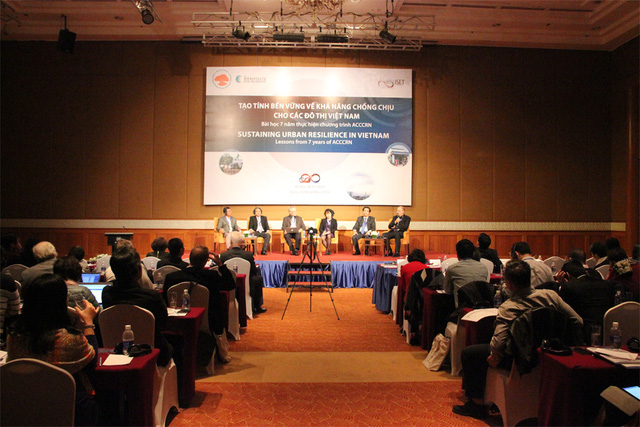Some 300 urban areas will be badly affected in future as Vietnam is in the top five most vulnerable countries to climate change according to a conference held in Hanoi on November 24.
The problem was discussed at the review conference seven years after the Asian Cities Climate Change Resilience Network (ACCCRN) programme was implemented. The conference was held by the Institute for Social and Environmental Transition (ISET) in Vietnam and the co-ordination units of ACCCRN.

The review conference seven years after the Asian Cities Climate Change Resilience Network (ACCCRN) programme was implemented
Tran Thi Lan Anh, Deputy Director of Urban Development Department under the Ministry of Construction said, "Vietnam has about 800 urban areas. Of which 300 coastal urban areas will be heavily affected by the climate change such as floods and salt water intrusion. About 140-150 urban areas in mountainous regions will be affected by landslides, flash floods and drought."
According to ISET, Vietnam is in the top five most vulnerable countries to climate change. The Vietnamese government adopted a National Target Program to Respond to Climate Change (NTP-RCC) in 2008. In 2009, the Rockefeller Foundation selected Can Tho, Danang and Quy Nhon cities to participate in the ACCCRN with seven other cities in Thailand, Indonesia and India.
The ACCCRN provide technical support to improve the city's capacity and resilience to deal with climate change. ISET was chosen to oversee the project in Vietnam. A climate change coordination office has been set up in each city to work with locality authorities as well as collect and analyse data.
Dao Anh Dung, vice chairman of Can Tho City said building a city that was resilient to climate change was one of their top concerns because landslide and flooding problems had gotten more serious in the city. "We have built a plan to improve awareness for state officials and people during 2010-2015 period and got help from a foreign fund to build a more long-term plan for 2015-2030 period," he said.
Talking about the difficulties when they have to combine the climate change programme with urban development planning, Luu Duc Cuong, head of the Vietnam Institute for Urban and Rural Planning said measures to cope with climate change were added much later.
"Climate change problems are unpredictable while the urban areas have been formed long ago. Although we have plans but the wide time frame or inaccurate forecasts have made it really difficult to add measures against climate change into the urban planning at first," he said.
He went on to say they had to calculate short-term economic efficiency while predicting the uncertain future.
"No matter how the climate change problem plays out, the measures that have or are being implemented won't go to waste," he said.
An urban development plan by the Urban Development Department, which was approved in 2013, gives priorities to Hanoi, Hai Phong, Danang, Can Tho and HCM cities. They will also focus on 30 other urban areas during 2015-2020 period. The plan aims to develop database, maps, policies and improve the ability to implement pilot scientific projects in Vietnamese urban areas.

Leave your comment on this story